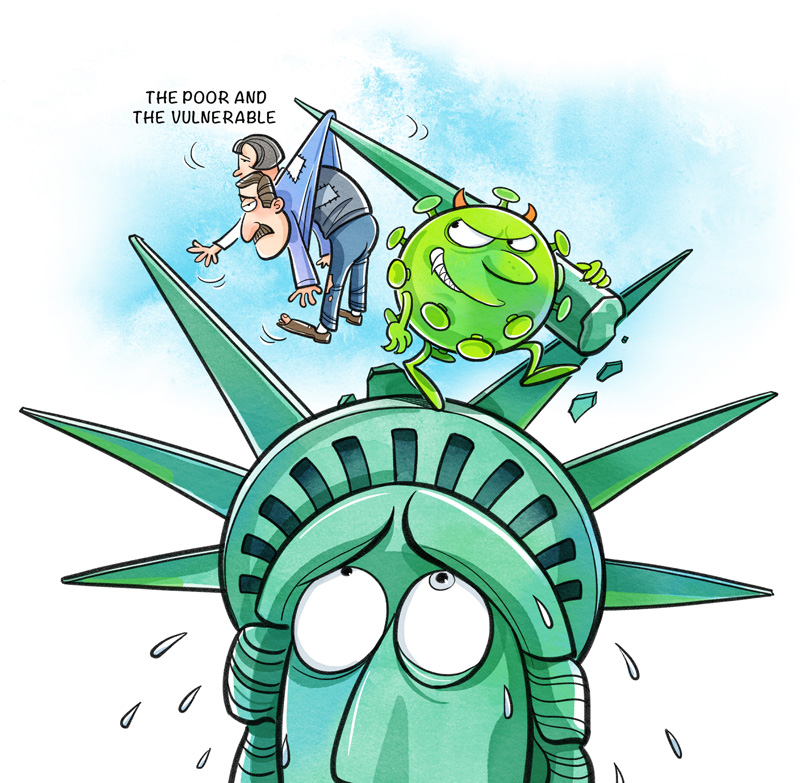Virus exposes US double standard on rights

By Zhang Yunfei
The novel coronavirus outbreak has exposed the hypocrisy of the United States as the self-proclaimed greatest defender of human rights. As of May 18, the novel coronavirus had infected more than 1.4 million people and claimed 85,000 lives in the US. In less than 100 days, the number of infections had crossed 1 million and deaths topped 60,000-the first infection was reported on Jan 21. And in only two months, the COVID-19 death toll had exceeded that in the Vietnam War. These cruel numbers mean loss of lives and broken families.
People’s rights to life and health are the most fundamental human rights and recognized and guaranteed by the Universal Declaration of Human Rights. Yet the US administration turned a deaf ear to the warnings from not only China and the World Health Organization but also the US intelligence community since early January, and refused to take action to control the spread of the virus, and thus prevent deaths. The US leader delayed ordering tests on people suspected to have contracted the virus, perhaps because the presidential election and political gains, not the lives of the people, are more important for him and other politicians.
Prompt US action could have prevented 90 percent deaths
An article in The Washington Post on May 3 said studies show that, if the US administration had implemented social distancing measures on March 2, instead of March 16, it could have prevented 90 percent of the COVID-19 patients from dying. The US accounts for less than 5 percent of the world’s population but more than 25 percent of the deaths worldwide. Due to the US administration’s lax attitude, incorrect policy and delayed action, the country is now the worst affected. Had it been any other country, the US would certainly have demanded a human rights inquiry by the UN Human Rights Council.
The novel coronavirus has spared no country. But data from the United Kingdom and the US show that the death rate among the poor is twice as much as those among the well-off. Data from the New York City Department of Health, show blacks and Hispanics dying from COVID-19 make up more than 60 percent of the city’s coronavirus-related fatalities. In Chicago, blacks make up roughly 33 percent of the population but account for almost 75 percent of the COVID-19 deaths. The numbers are equally grim and lopsided in Louisiana, the Carolinas and Michigan.
In the US, colored people have always faced disparity in healthcare. And income inequality and inadequate access to good healthcare services have further worsened the situation for the poor. A recent report by Rubix, a medical research firm, says African Americans exhibiting coronavirus symptoms are less likely to be tested, possibly delaying treatment and putting their lives at greater risk. Hispanics are not much better; the death rate among them is twice as high as whites in New York City.
Since the outbreak, “the rich first” policy and “white supremacy” have become even more visible. The US is among the world’s wealthiest countries, but its wealth is concentrated in the hands of a small number of people. According to the Brookings Institution, the net worth of a typical white family is $171,000, nearly 10 times greater than a black family’s typical net wealth of $17,150. And the wealth gap leads to various opportunity gaps, reflected in higher rates of infection and deaths among colored people. Apart from devastating the colored people, the virus has also exposed the damage caused by structural racism in the US.
Racism and xenophobia a plague in US society
The outbreak has also drastically increased racism and xenophobia in the US. Asian Americans have been stigmatized, attacked, sprayed with disinfectants and denied entry into restaurants.
In the initial stage of the epidemic in China, some US and other Western politicians as well as media outlets gloated over the loss of human lives and the economic damage China was suffering. They helped spread prejudiced and racist stories about the Chinese people. On Feb 3, The Wall Street Journal published an opinion piece, headlined “China is the Real Sick Man of Asia”, which was outright racist and slanderous. And many Chinese visitors to the US and some European countries have been verbally abused, harassed, and pelted with eggs.
Strict quarantine is a common practice in the fight against any infectious disease. Yet some Western media outlets responded differently to the same measure taken by countries with different political systems. To contain the outbreak, the Italian government locked down the entire country-China had done the same in Wuhan, and its parent province of Hubei.
The New York Times spoke highly of Italy’s lockdown, saying “the sudden expansion of travel restrictions reflected the government’s efforts to catch up to the spread of a virus that has consistently outpaced its efforts to contain it”, but argued that China’s lockdown “has come at great costs to people’s livelihoods and personal liberties”. Another article in the NYT said China’s “grim management system … divides the country into tiny sections and assign people to watch over each, ensuring a tight grip over a large population”.
Double standard is what many Western media outlets have been practicing for decades. They boast of objective and unbiased reporting, yet they don’t miss even one single opportunity to attack countries that have political systems different from the West’s, especially China, even though the virus has nothing to do with political systems.
Washington’s blame game exposes its hypocrisy
This is the sobering reality of the US’ hypocrisy in terms of human rights. The global public health crisis has highlighted the gloom in US society and the lack of protection of fundamental human rights. As such, the US administration should stop playing the blame game, as it cannot help it disguise its failure to contain the pandemic.
The outbreak is a reminder that all countries are part of a global community that shares an uncertain future, and that no country alone can meet common challenges-and only solidarity and cooperation can help us overcome the health crisis.
The author is a board member of the United Nations Association of China. The views don’t necessarily reflect those of China Daily.








